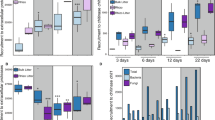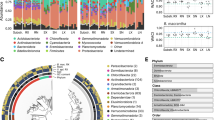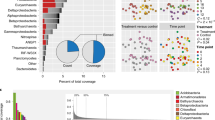Abstract
Phosphorus is a scarce nutrient in many tropical ecosystems, yet how soil microbial communities cope with growth-limiting phosphorus deficiency at the gene and protein levels remains unknown. Here, we report a metagenomic and metaproteomic comparison of microbial communities in phosphorus-deficient and phosphorus-rich soils in a 17-year fertilization experiment in a tropical forest. The large-scale proteogenomics analyses provided extensive coverage of many microbial functions and taxa in the complex soil communities. A greater than fourfold increase in the gene abundance of 3-phytase was the strongest response of soil communities to phosphorus deficiency. Phytase catalyses the release of phosphate from phytate, the most recalcitrant phosphorus-containing compound in soil organic matter. Genes and proteins for the degradation of phosphorus-containing nucleic acids and phospholipids, as well as the decomposition of labile carbon and nitrogen, were also enhanced in the phosphorus-deficient soils. In contrast, microbial communities in the phosphorus-rich soils showed increased gene abundances for the degradation of recalcitrant aromatic compounds, transformation of nitrogenous compounds and assimilation of sulfur. Overall, these results demonstrate the adaptive allocation of genes and proteins in soil microbial communities in response to shifting nutrient constraints.
This is a preview of subscription content, access via your institution
Access options
Access Nature and 54 other Nature Portfolio journals
Get Nature+, our best-value online-access subscription
$29.99 / 30 days
cancel any time
Subscribe to this journal
Receive 12 digital issues and online access to articles
$119.00 per year
only $9.92 per issue
Buy this article
- Purchase on Springer Link
- Instant access to full article PDF
Prices may be subject to local taxes which are calculated during checkout





Similar content being viewed by others
References
Condron, L. M., Turner, B. L. & Cade-Menun, B. J. in Phosphorus: Agriculture and the Environment (eds Sims, J. & Sharpley, A.) 87–121 (American Society of Agronomy, Madison, 2005).
Sharma, S. B., Sayyed, R. Z., Trivedi, M. H. & Gobi, T. A. Phosphate solubilizing microbes: sustainable approach for managing phosphorus deficiency in agricultural soils. Springerplus 2, 587 (2013).
Turner, B. L. & Wright, S. J. The response of microbial biomass and hydrolytic enzymes to a decade of nitrogen, phosphorus, and potassium addition in a lowland tropical rain forest. Biogeochemistry 117, 115–130 (2014).
Quesada, C. A. et al. Soils of Amazonia with particular reference to the RAINFOR sites. Biogeosciences 8, 1415–1440 (2011).
Wright, S. J. et al. Potassium, phosphorus, or nitrogen limit root allocation, tree growth, or litter production in a lowland tropical forest. Ecology 92, 1616–1625 (2011).
Wurzburger, N. & Wright, S. J. Fine-root responses to fertilization reveal multiple nutrient limitation in a lowland tropical forest. Ecology 96, 2137–2146 (2015).
Santiago, L. S. et al. Tropical tree seedling growth responses to nitrogen, phosphorus and potassium addition. J. Ecol. 100, 309–316 (2012).
Mayor, J. R., Wright, S. J. & Turner, B. L. Species-specific responses of foliar nutrients to long-term nitrogen and phosphorus additions in a lowland tropical forest. J. Ecol. 102, 36–44 (2014).
Liu, L., Gundersen, P., Zhang, T. & Mo, J. M. Effects of phosphorus addition on soil microbial biomass and community composition in three forest types in tropical China. Soil. Biol. Biochem. 44, 31–38 (2012).
Cassman, N. A. et al. Plant and soil fungal but not soil bacterial communities are linked in long-term fertilized grassland. Sci. Rep. 6, 23680 (2016).
Jonasson, S., Michelsen, A., Schmidt, I. K. & Nielsen, E. V. Responses in microbes and plants to changed temperature, nutrient, and light regimes in the Arctic. Ecology 80, 1828–1843 (1999).
Rinnan, R., Michelsen, A., Baath, E. & Jonasson, S. Fifteen years of climate change manipulations alter soil microbial communities in a subarctic heath ecosystem. Glob. Chang. Biol. 13, 28–39 (2007).
Koyama, A., Wallenstein, M. D., Simpson, R. T. & Moore, J. C. Carbon-degrading enzyme activities stimulated by increased nutrient availability in Arctic tundra soils. PLoS. ONE 8, e77212 (2013).
Mack, M. C., Schuur, E. A., Bret-Harte, M. S., Shaver, G. R. & Chapin, F. S. Ecosystem carbon storage in Arctic tundra reduced by long-term nutrient fertilization. Nature 431, 440–443 (2004).
Tveit, A., Schwacke, R., Svenning, M. M. & Urich, T. Organic carbon transformations in high-Arctic peat soils: key functions and microorganisms. ISME J. 7, 299–311 (2013).
Hultman, J. et al. Multi-omics of permafrost, active layer and thermokarst bog soil microbiomes. Nature 521, 208–212 (2015).
Butterfield, C. N. et al. Proteogenomic analyses indicate bacterial methylotrophy and archaeal heterotrophy are prevalent below the grass root zone. PeerJ 4, e2687 (2016).
Xue, K. et al. Tundra soil carbon is vulnerable to rapid microbial decomposition under climate warming. Nat. Clim. Change 6, 595–600 (2016).
Jorquera, M. A. et al. Identification of beta-propeller phytase-encoding genes in culturable Paenibacillus and Bacillus spp. from the rhizosphere of pasture plants on volcanic soils. FEMS Microbiol. Ecol. 75, 163–172 (2011).
Mullaney, E. J. & Ullah, A. H. The term phytase comprises several different classes of enzymes. Biochem. Biophys. Res. Commun. 312, 179–184 (2003).
Lim, B. L., Yeung, P., Cheng, C. & Hill, J. E. Distribution and diversity of phytate-mineralizing bacteria. ISME J. 1, 321–330 (2007).
Turner, B. L. et al. Seasonal changes and treatment effects on soil inorganic nutrients following a decade of fertilizer addition in a lowland tropical forest. Soil. Sci. Soc. Am. J. 77, 1357–1369 (2013).
Turner, B. L., Yavitt, J. B., Harms, K. E., Garcia, M. N. & Wright, S. J. Seasonal changes in soil organic matter after a decade of nutrient addition in a lowland tropical forest. Biogeochemistry 123, 221–235 (2015).
Turner, B. L., Wells, A. & Condron, L. M. Soil organic phosphorus transformations along a coastal dune chronosequence under New Zealand temperate rain forest. Biogeochemistry 121, 595–611 (2014).
Turner, B. L. & Engelbrecht, B. M. J. Soil organic phosphorus in lowland tropical rain forests. Biogeochemistry 103, 297–315 (2011).
Turner, B. L. Resource partitioning for soil phosphorus: a hypothesis. J. Ecol. 96, 698–702 (2008).
Funk, J. L. & Vitousek, P. M. Resource-use efficiency and plant invasion in low-resource systems. Nature 446, 1079–1081 (2007).
Cleveland, C. C. & Liptzin, D. C:N:P stoichiometry in soil: is there a “Redfield ratio” for the microbial biomass? Biogeochemistry 85, 235–252 (2007).
Sterner, R. W. & Elser, J. J. Ecological Stoichiometry: The Biology of Elements from Molecules to the Biosphere (Princeton Univ. Press, Princeton, 2002).
Zechmeister-Boltenstern, S. et al. The application of ecological stoichiometry to plant–microbial–soil organic matter transformations. Ecol. Monogr. 85, 133–155 (2015).
Kaspari, M. et al. Multiple nutrients limit litterfall and decomposition in a tropical forest. Ecol. Lett. 11, 35–43 (2008).
Tilman, D. Resource Competition and Community Structure (Princeton Univ. Press, Princeton, 1982).
Bloom, A. J., Chapin, F. S. & Mooney, H. A. Resource limitation in plants—an economic analogy. Annu. Rev. Ecol. Syst. 16, 363–392 (1985).
Allison, S. D. & Vitousek, P. M. Responses of extracellular enzymes to simple and complex nutrient inputs. Soil. Biol. Biochem. 37, 937–944 (2005).
Gleeson, S. K. & Tilman, D. Plant allocation and the multiple limitation hypothesis. Am. Nat. 139, 1322–1343 (1992).
Hurt, R. A. et al. Improved yield of high molecular weight DNA coincides with increased microbial diversity access from iron oxide cemented sub-surface clay environments. PLoS ONE 9, e102826 (2014).
Haider, B. et al. Omega: an overlap-graph de novo assembler for metagenomics. Bioinformatics 30, 2717–2722 (2014).
Varghese, N. J. et al. Microbial species delineation using whole genome sequences. Nucleic Acids Res. 43, 6761–6771 (2015).
Buchfink, B., Xie, C. & Huson, D. H. Fast and sensitive protein alignment using DIAMOND. Nat. Methods 12, 59–60 (2015).
Chai, J., Kora, G., Ahn, T. H., Hyatt, D. & Pan, C. Functional phylogenomics analysis of bacteria and archaea using consistent genome annotation with UniFam. BMC Evolut. Biol. 14, 207 (2014).
Robinson, M. D., McCarthy, D. J. & Smyth, G. K. edgeR: a bioconductor package for differential expression analysis of digital gene expression data. Bioinformatics 26, 139–140 (2010).
Jonsson, V., Osterlund, T., Nerman, O. & Kristiansson, E. Statistical evaluation of methods for identification of differentially abundant genes in comparative metagenomics. BMC Genom. 17, 78 (2016).
Zhang, Z. H. et al. A comparative study of techniques for differential expression analysis on RNA-Seq data. PLoS. ONE 9, e103207 (2014).
Rapaport, F. et al. Comprehensive evaluation of differential gene expression analysis methods for RNA-Seq data. Genome Biol. 14, R95 (2013).
Huang, D. W., Sherman, B. T. & Lempicki, R. A. Systematic and integrative analysis of large gene lists using DAVID bioinformatics resources. Nat. Protoc. 4, 44–57 (2009).
Mosier, A. C. et al. Elevated temperature alters proteomic responses of individual organisms within a biofilm community. ISME J. 9, 180–194 (2015).
Hyatt, D., LoCascio, P. F., Hauser, L. J. & Uberbacher, E. C. Gene and translation initiation site prediction in metagenomic sequences. Bioinformatics 28, 2223–2230 (2012).
Langmead, B. & Salzberg, S. L. Fast gapped-read alignment with Bowtie 2. Nat. Methods 9, 357–359 (2012).
Kang, D. D., Froula, J., Egan, R. & Wang, Z. MetaBAT, an efficient tool for accurately reconstructing single genomes from complex microbial communities. PeerJ 3, e1165 (2015).
Wu, Y. W., Simmons, B. A. & Singer, S. W. MaxBin 2.0: an automated binning algorithm to recover genomes from multiple metagenomic datasets. Bioinformatics 32, 605–607 (2016).
Parks, D. H., Imelfort, M., Skennerton, C. T., Hugenholtz, P. & Tyson, G. W. CheckM: assessing the quality of microbial genomes recovered from isolates, single cells, and metagenomes. Genome Res. 25, 1043–1055 (2015).
Segata, N., Bornigen, D., Morgan, X. C. & Huttenhower, C. PhyloPhlAn is a new method for improved phylogenetic and taxonomic placement of microbes. Nat. Commun. 4, 2304 (2013).
Letunic, I. & Bork, P. Interactive Tree Of Life v2: online annotation and display of phylogenetic trees made easy. Nucleic Acids Res. 39, W475–W478 (2011).
Oyserman, B. O., Noguera, D. R., del Rio, T. G., Tringe, S. G. & McMahon, K. D. Metatranscriptomic insights on gene expression and regulatory controls in Candidatus Accumulibacter phosphatis. ISME J. 10, 810–822 (2016).
Davis, M. P., van Dongen, S., Abreu-Goodger, C., Bartonicek, N. & Enright, A. J. Kraken: a set of tools for quality control and analysis of high-throughput sequence data. Methods 63, 41–49 (2013).
Li, Z. et al. Diverse and divergent protein post-translational modifications in two growth stages of a natural microbial community. Nat. Commun. 5, 4405 (2014).
Wang, Y., Ahn, T. H., Li, Z. & Pan, C. Sipros/ProRata: a versatile informatics system for quantitative community proteomics. Bioinformatics 29, 2064–2065 (2013).
Guo, X. et al. Sipros ensemble improves database searching and filtering for complex metaproteomics. Bioinformatics https://doi.org/10.1093/bioinformatics/btx601 (2017).
Li, Z. et al. Integrated proteomics and metabolomics suggests symbiotic metabolism and multimodal regulation in a fungal-endobacterial system. Environ. Microbiol. 19, 1041–1053 (2017).
Tyanova, S. et al. The Perseus computational platform for comprehensive analysis of (prote)omics data. Nat. Methods 13, 731–740 (2016).
Lazar, C., Gatto, L., Ferro, M., Bruley, C. & Burger, T. Accounting for the multiple natures of missing values in label-free quantitative proteomics data sets to compare imputation strategies. J. Proteome Res. 15, 1116–1125 (2016).
Gee, G. W. & Or, D. in Methods of Soil Analysis: Part 4—Physical Methods SSSA Book Series 5.4 (eds Dane, J. H. & Topp, G. C.) 255–294 (Soil Science Society of America, Madison, 2002).
Loeppert, R. L. & Inskeep, W. P. in Methods of Soil Analysis: Part 3 — Chemical Methods SSSA Book Series 5.3 (ed. Sparks, D. L.) 639–654 (Soil Science Society of America, Madison, 1996).
Beck, T. et al. An inter-laboratory comparison of ten different ways of measuring soil microbial biomass C. Soil. Biol. Biochem. 29, 1023–1032 (1997).
Brookes, P. C., Landman, A., Pruden, G. & Jenkinson, D. S. Chloroform fumigation and the release of soil nitrogen: a rapid direct extraction method to measure microbial biomass nitrogen in soil. Soil. Biol. Biochem. 17, 837–842 (1985).
Tfaily, M. M. et al. Sequential extraction protocol for organic matter from soils and sediments using high resolution mass spectrometry. Anal. Chim. Acta 972, 54–61 (2017).
Kujawinski, E. B., Longnecker, K., Barott, K. L., Weber, R. J. M. & Kido Soule, M. C. Microbial community structure affects marine dissolved organic matter composition. Front. Mar. Sci. 3, 45 (2016).
Tfaily, M. M. et al. Advanced solvent based methods for molecular characterization of soil organic matter by high-resolution mass spectrometry. Anal. Chem. 87, 5206–5215 (2015).
Acknowledgements
This work was supported by Laboratory Directed Research and Development funding from Oak Ridge National Laboratory (ORNL). The authors acknowledge R. Hurt of ORNL’s Biosciences Division for assistance with DNA extractions from tropical soils and J. Phillips of ORNL’s Environmental Sciences Division for soil characterization. The metagenomic sequencing was conducted by the US Department of Energy (DOE) Joint Genome Institute (JGI). The Fourier transform ion cyclotron resonance MS analyses were performed by the Environmental Molecular Sciences Laboratory (EMSL). The JGI and EMSL are DOE Office of Science User Facilities sponsored by the Office of Biological and Environmental Research. This research used resources of the Oak Ridge Leadership Computing Facility. The ORNL and JGI are supported by the Office of Science of the US DOE under contract numbers DE-AC05-00OR22725 and DE-AC02-05CH11231, respectively.
Author information
Authors and Affiliations
Contributions
C.P. and M.A.M. designed the project. M.A.M., C.P., S.J.W. and B.L.T. performed the soil sampling. Q.Y., T.C.H., S.G.T. and C.P. performed the metagenomics. Z.L. and X.G. performed the metaproteomics. Q.Y. and M.A.M. performed the enzyme assay. M.M.T., L.P.-T. and Y.S. performed the soil organic matter analysis. Q.Y. and C.P. analysed the meta-omics results. B.L.T., S.J.W. and M.A.M. assisted in interpretation of the results. The manuscript was drafted by Q.Y. and C.P. and revised by all authors.
Corresponding author
Ethics declarations
Competing interests
The authors declare no competing financial interests.
Additional information
Publisher’s note: Springer Nature remains neutral with regard to jurisdictional claims in published maps and institutional affiliations.
Supplementary information
Supplementary Information
Supplementary Figures 1 and 2
Supplementary Data 1
Summary of the community proteogenomic results
Supplementary Data 2
Differential analysis of gene abundances by EC numbers and GO terms in the Gigante soil metagenomes
Supplementary Data 3
Assembly and pathway analysis of the near-complete genomes
Supplementary Data 4
Differential analysis of protein abundances by EC numbers and GO terms in the Gigante soil metaproteomes
Supplementary Data 5
Measurement of soil properties
Supplementary Data 6
Measurement of soil organic matter by Fourier Transform Ion Cyclotron Resonance Mass Spectrometry (FTICR-MS)
Rights and permissions
About this article
Cite this article
Yao, Q., Li, Z., Song, Y. et al. Community proteogenomics reveals the systemic impact of phosphorus availability on microbial functions in tropical soil. Nat Ecol Evol 2, 499–509 (2018). https://doi.org/10.1038/s41559-017-0463-5
Received:
Accepted:
Published:
Issue Date:
DOI: https://doi.org/10.1038/s41559-017-0463-5
This article is cited by
-
Conversion of steppe to cropland increases spatial heterogeneity of soil functional genes
The ISME Journal (2023)
-
Microbial phosphorus recycling in soil by intra- and extracellular mechanisms
ISME Communications (2023)
-
Antimony efflux underpins phosphorus cycling and resistance of phosphate-solubilizing bacteria in mining soils
The ISME Journal (2023)
-
Soil phosphorus availability alters the effects of straw carbon on microbial mediated phosphorus conversion
Plant and Soil (2023)
-
Divergent responses of soil microbial metabolic limitations to cropland revegetation at erosion and deposition topographies in the hilly-gully region of the northern Loess Plateau, China
Plant and Soil (2023)



